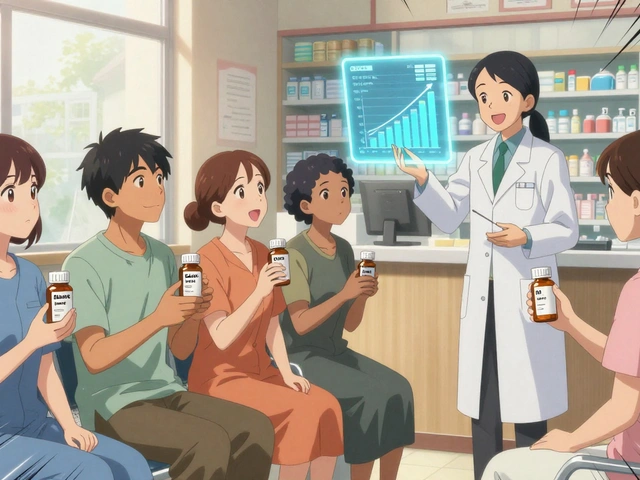The Silent Epidemic: Antibiotic-Resistant Infections on the Rise
As a society, we've come to rely heavily on antibiotics to combat bacterial infections. They've been our go-to solution for decades, and they've saved countless lives. But over time, our dependence on these miracle drugs has led to a silent epidemic: the rise of antibiotic-resistant infections. These so-called "superbugs" are becoming increasingly common, and they pose a significant threat to our health and well-being. In this article, we'll explore the factors driving the rise of antibiotic-resistant infections and discuss what we can do to mitigate this growing concern.
Understanding Antibiotic Resistance: How Bacteria Fight Back
Before we dive into the issue of antibiotic-resistant infections, it's important to understand how bacteria become resistant to these drugs in the first place. Antibiotics work by targeting specific components of bacterial cells, such as cell walls or protein production. But bacteria are constantly evolving and adapting to their environment, including the presence of antibiotics. As a result, some bacteria develop defenses against these drugs, rendering them ineffective. This process is known as antibiotic resistance, and it's at the heart of the growing concern surrounding antibiotic-resistant infections.
The Overuse and Misuse of Antibiotics: Fueling the Resistance
One of the main reasons why antibiotic-resistant infections are becoming more common is the overuse and misuse of antibiotics. When we take antibiotics unnecessarily or don't complete the full course of treatment, we give bacteria the opportunity to develop resistance. This is especially true when low doses of antibiotics are used, as they can kill off the weaker bacteria while allowing the more resistant ones to survive and multiply. This creates a breeding ground for superbugs, which can then spread to other people and cause difficult-to-treat infections.
Antibiotics in Agriculture: An Underlying Problem
Another significant contributor to the rise of antibiotic-resistant infections is the widespread use of antibiotics in agriculture. Farmers often give these drugs to livestock to promote growth and prevent illness, even when there's no sign of infection. This practice can lead to the development of resistant bacteria in animals, which can then be passed on to humans through contact with contaminated meat or other animal products. As a result, our food supply has become an unwitting accomplice in the spread of antibiotic resistance.
The Health Risks of Antibiotic-Resistant Infections
Antibiotic-resistant infections are more than just a nuisance; they can pose serious health risks. When bacteria become resistant to multiple antibiotics, infections can become difficult – or even impossible – to treat. This can lead to longer illness durations, more complicated treatment plans, and even death. In fact, the World Health Organization has identified antibiotic resistance as one of the top 10 global public health threats facing humanity.
Preventing the Spread of Antibiotic-Resistant Infections
While the issue of antibiotic-resistant infections can seem overwhelming, there are steps we can take to help prevent the spread of these superbugs. First and foremost, we must use antibiotics responsibly. This means only taking them when absolutely necessary, and always completing the full course of treatment as prescribed. Additionally, we should practice good hygiene, such as regular hand-washing and safe food-handling practices, to help reduce the spread of bacteria in general.
Developing New Antibiotics: A Race Against Time
As antibiotic resistance continues to grow, there's a pressing need for new antibiotics to combat these hard-to-treat infections. Unfortunately, developing new drugs is both time-consuming and expensive, and many pharmaceutical companies have scaled back their antibiotic research efforts in recent years. However, there are some promising new drugs in development that may help us stay ahead of the rising tide of antibiotic resistance. It's crucial that we continue to invest in this research to ensure we have the tools we need to combat these dangerous infections.
Alternative Treatments: Exploring Other Options
While new antibiotics are certainly needed, it's also important to explore alternative treatments for bacterial infections. These could include phage therapy, which uses viruses that infect and kill bacteria; bacteriocins, which are naturally occurring antibacterial proteins; and even the use of predatory bacteria that consume other bacteria. By diversifying our arsenal of infection-fighting tools, we can help reduce our reliance on antibiotics and slow the spread of antibiotic resistance.
Public Awareness and Education: A Key Component
Finally, one of the most critical aspects of addressing the issue of antibiotic-resistant infections is raising public awareness and education. Many people are unaware of the dangers of antibiotic resistance and the role they play in its spread. By educating ourselves and others about this growing concern, we can help promote responsible antibiotic use and encourage the adoption of alternative treatments and prevention strategies.
Conclusion: A Growing Concern, but Not an Insurmountable Challenge
The rise of antibiotic-resistant infections is undoubtedly a cause for concern. However, by understanding the factors driving this problem and taking steps to address them, we can help mitigate its impact on our health and well-being. This will require a concerted effort from individuals, healthcare providers, and policymakers alike, but together, we can work towards a future where antibiotic resistance is no longer a looming threat.




It is absolutely imperative, and I repeat, absolutely imperative, that we confront the burgeoning crisis of antibiotic resistance, for the sake of public health, for the sake of future generations, and for the moral integrity of our society; the data, as presented by countless studies, leave no room for doubt. The reckless overprescription of antibiotics, the cavalier disregard for proper dosing regimens, the complacent belief that modern medicine is invincible, all coalesce into a perfect storm, a veritable maelstrom of microbial evolution. Physicians, pharmacists, and patients alike must internalize, with unwavering conviction, the principle that antibiotics are not a trivial commodity; they are a finite resource, a priceless therapeutic arsenal, and must be stewarded with the utmost care. Moreover, the agricultural sector, in its relentless pursuit of profit, has turned to prophylactic antibiotics with abandon, contaminating the food chain, and expediting the spread of resistant strains; this practice is wholly indefensible. Regulatory bodies, entrusted with the protection of public welfare, must enact stringent policies-mandatory reporting, surveillance of resistance patterns, and penalties for non‑compliance-without delay. Researchers, too, shoulder a profound responsibility; they must prioritize the development of novel antimicrobial agents, invest in alternative therapies such as phage therapy, and elucidate the mechanisms of resistance at the molecular level, thereby furnishing us with new weapons. Public education campaigns, designed with precision and cultural sensitivity, must permeate schools, workplaces, and media outlets, dispelling myths and fostering responsible antibiotic usage; the populace cannot remain ignorant. Hand hygiene, a simple yet profoundly effective measure, must be championed, for it constitutes the first line of defense against opportunistic infections. The World Health Organization’s designation of antibiotic resistance as a top ten global health threat is a clarion call, a summons to action that we must heed. In short, every stakeholder-government, industry, healthcare professionals, and citizens-must collaborate, commit, and act, lest we descend into a post‑antibiotic era fraught with untreatable disease. The stakes could not be higher, the timeline could not be shorter, and the consequences, should we fail, could be catastrophic. Let us, therefore, rise, let us speak, let us implement, and let us safeguard the efficacy of antibiotics for all.
Wow, i cant believe how many people just blast antibiotics like candy, dont even finish the whole course-its like, seriously? that kinda habit is what fuels those superbugs, and it makes me angry, dude! we need real talk: stop the overuse, read the label, and actually finish it, ok? otherwise we’re just handing the germs a free pass. keep it real, guys.
When we examine the pharmacodynamics of beta‑lactam antibiotics, it becomes evident that sub‑inhibitory concentrations-often a result of incomplete courses-select for multidrug‑resistant (MDR) pathogens, thereby compromising therapeutic efficacy. From a systems‑level perspective, antimicrobial stewardship programs (ASPs) must integrate both prescriber education and real‑time microbiological feedback loops, fostering a culture of evidence‑based prescribing. Moreover, the One Health framework underscores the interconnectedness of human, animal, and environmental health, highlighting that agricultural antibiotic utilization contributes to the resistome in a quantifiable manner. To mitigate these dynamics, interdisciplinary collaboration among clinicians, veterinarians, epidemiologists, and policymakers is paramount. Empowering patients through transparent risk communication not only demystifies resistance mechanisms but also cultivates shared responsibility, ultimately curbing the propagation of superbugs.
Let me tell you, this whole “One Health” narrative is just a smokescreen concocted by globalist elites, pushing a hidden agenda to control our food supply and strip America of its sovereignty. They want us to believe that foreign antibiotics are the villains, while the real culprits-Big Pharma and the government’s covert programs-are pumping resistance‑inducing chemicals into our water. If we keep buying into their lies, we’ll watch our great nation crumble under a wave of untreatable infections, orchestrated by the very agencies sworn to protect us! It’s high time we expose this plot and demand true transparency.
Considering the complexities of microbial adaptation, it is understandable why the emergence of resistant strains feels inevitable, yet we must not succumb to fatalism. Empathy towards patients battling these infections can inspire a collective willingness to adopt preventive measures. By fostering dialogue across disciplines, we can bridge gaps in knowledge and nurture a shared commitment to stewardship. Patience, humility, and open‑mindedness will serve as the backbone of any sustainable solution. In the end, our shared humanity may prove stronger than any superbug.
I wish to express my sincere appreciation for the thoughtful considerations presented herein. It is incumbent upon us, as members of the scientific community, to uphold rigorous standards of conduct and to promote judicious antibiotic use. Accordingly, I recommend the implementation of structured educational modules within medical curricula, complemented by continuous professional development for practicing clinicians. Such measures, undertaken with due diligence, shall advance our collective endeavor to mitigate resistance.
One of the most effective strategies we can adopt right now is to strengthen community‑level infection control initiatives, such as regular hand‑washing campaigns and vaccination drives, which directly reduce the incidence of bacterial infections that otherwise require antibiotic treatment. Additionally, encouraging physicians to utilize rapid diagnostic testing can help differentiate viral from bacterial illnesses, thereby preventing unnecessary prescriptions. It’s also crucial to support research funding for novel therapeutics, including phage therapy and antimicrobial peptides, which could diversify our arsenal. By combining public education with robust clinical guidelines, we can make measurable progress against resistance. Let’s champion these actions together.
yeah, that sounds good – just keep it simple and real.
Let’s stay proactive and champion responsible antibiotic use now!
Indeed, taking decisive steps today-such as adhering to prescribed regimens and supporting antimicrobial stewardship-will safeguard treatment efficacy for future patients. Your enthusiasm is commendable, and I fully endorse these initiatives.
Antibiotic resistance epitomizes a broader paradox of human progress: our triumphs in medicine inadvertently sow the seeds of future vulnerability. This dialectic urges us to reflect on the ethical dimensions of technological advancement and to cultivate humility in our interventions. By reconceptualizing antibiotics as a shared commons rather than an infinite resource, we can align our policies with principles of intergenerational equity. Such a paradigm shift demands both scientific insight and moral imagination, urging societies to act responsibly. Ultimately, the stewardship of these life‑saving drugs reflects our collective character.
While the preceding arguments are laudable, one must acknowledge that the emphasis on antibiotic stewardship may inadvertently impede clinical flexibility, particularly in emergent settings where rapid empiric therapy is indispensable. Moreover, the portrayal of pharmaceutical enterprises as monolithic antagonists neglects the substantive contributions of private sector research in advancing novel antimicrobial agents. A balanced discourse should therefore consider the potential drawbacks of overly restrictive policies, ensuring that patient outcomes remain paramount. In this vein, it is advisable to adopt a nuanced approach that integrates both stewardship and pragmatic clinical judgment.
Thank you for illuminating this critical issue 😊.